Module B: Develop and Execute a Content Plan for Instagram
Let the journey begin! In this module, you will learn how to effectively develop your content plan in a way that connects with your audience, uncovering techniques to create attractive and persuasive content that stands out on Instagram.
You’ll also gain access to strategic templates walking you through Metricool’s platform to schedule and optimize content.
1. Outline your content plan
With your strategy in hand, it’s time to define your content plan for Instagram. Remember to not lose sight of your overall strategy, keeping your ideal customer in mind, main goals, and brand voice. This way, you can clearly create content that hits your target audience.
But, where can you find content ideas? A starting point is recognizing your ideal customer’s pain points and aspirations.
Imagine you run a limited edition sneaker store and David, a 30-year-old fashion enthusiast based in Los Angeles is your ideal customer. What are David’s pain points and aspirations?
His pain points could be the following, for example: high prices and authenticity. He may be concerned with the high cost of limited sneakers and while he’s willing to pay more, he wants to ensure the sneakers are worth the investment and of high quality.
On the other hand, his aspirations could be exclusive access to new releases and limited editions, to become a style reference.
With this information, creating content that connects and impacts users like David is simple once you break it down. Transform these ideas into posts, for example, sharing comparisons and reviews to exemplify high-quality products. A reel could show users how to pair the new release sneakers, and Stories could alert followers of limited stock. The former sparks inspiration and the latter demonstrates FOMO (Fear of Missing Out) in the exclusivity of the shoe.
Moving theory to practice, this same template we mentioned earlier will become your best ally.
In this, you will find a content matrix in the “Strategy” tab which will serve as a guide to transforming these desires and aspirations into concrete content. Use this to record all your content ideas, keeping in mind that more than 50 ideas can arise from the same pain point.
Then, go to the planning template and turn these ideas into posts by adding the caption, images, videos, and any other resources you need.
But wait! This comes with a useful trick. You can dump this template into Metricool and schedule all content at once.
These quick videos will show you how to plan and upload content with the CSV.
How to Export Your Instagram Content in CSV Format
How to Import the CSV into Metricool’s Planner
MetriTip: The CSV template isn’t just for Instagram! You can use it to upload content to other platforms as well. Check out this video to learn more.
2. Create content that WORKS on Instagram
Looks like all our work is done, doesn’t it, Metricooler? Well, it’s actually only just begun. It’s time to figure out how to give your content that spark to make it stand out from the rest!
While there is no magic formula that will make you shine, there ARE proven strategies that will help you hit the nail on the head with your content.
2.1 10 tips to stand out on Instagram
1. Respect the recommended content sizes.
It seems obvious, but it really can make or break your content when users are scrolling. We recommend checking from time to time for updated sizes. You don’t want Instagram to cut off the most important part of your sentence or distort the graphic you spent so much time on. Check all the updated sizes here.
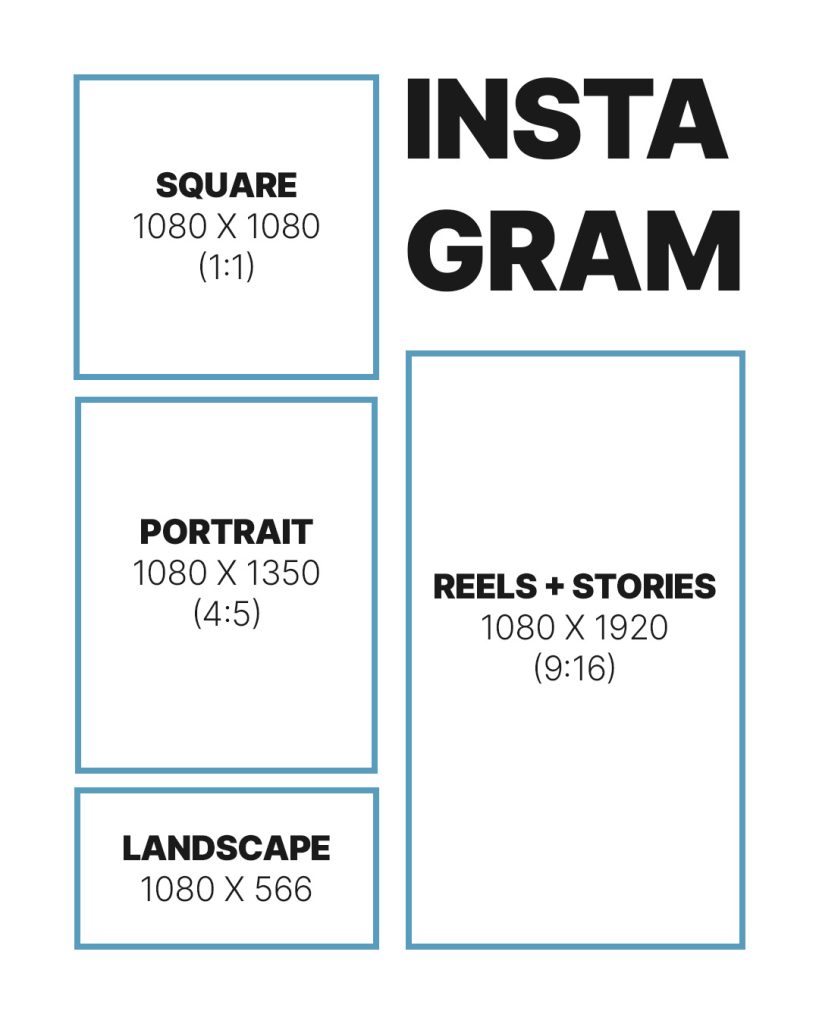
| Post | Instagram photo size |
|---|---|
| Profile photo | 110×110 px (recommended 320 x 320) |
| Square photos | 1080 x 1080 px |
| Horizontal photos (landscape) | 1080 x 566 px |
| Vertical photos | 1080 x 1350 px |
| Square videos | 600 x 600 px |
| Horizontal videos | 600 x 315 px |
| Vertical videos | 600 x 750 px |
| Stories | 750 x 1334 px |
| Video Stories | 750 x 1334 px |
| Reels | 1080 x 1920 px |
| Square Ad | 1080 x 1080 px |
| Landscape format Ad | 1080 x 566 px |
| Vertical format Ad | 1080 x 1080 px |
2. Do not neglect the visual quality of your content.
Make sure your videos are well-lit and your images look clear. You don’t need a fancy set-up to record your videos, but small changes can make a huge difference in quality. Remember to clean your phone camera before recording or taking a picture and if possible, use natural light. A ring light can also make all the difference.
3. Take care of your feed.
Although having a perfect feed is ancient history on Instagram, there are still things you should keep in mind! Don’t neglect aesthetics completely. Remember, you only have a few seconds to capture the attention of a user when they click on your profile. Use tools like Metricool’s feed preview to check that all your images and videos are displayed correctly on the feed. It’s good practice to always look at the feed preview once you are done scheduling your content.
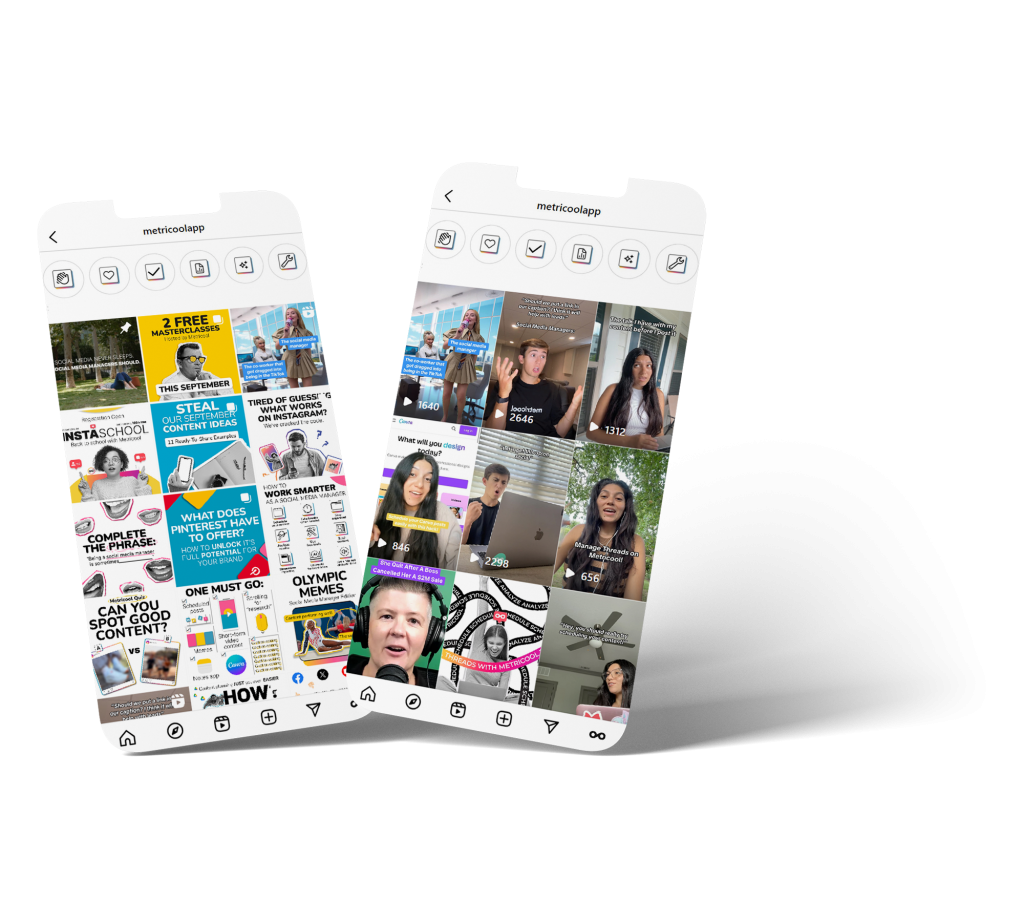
4. Diversify your formats.
Instagram gives you a multitude of formats to get the most out of the social network. So don’t base your strategy on just one content type. The platform wants you to use all their features. Create Reels, Stories, carousels, and single-image posts. Each format helps you achieve different goals and using them wisely will help you grow faster on Instagram.
5. Take extra care with carousels.
As we saw recently in our 2024 Instagram Study, carousels are the king of engagement on the social network. This means you should be creating carousels that engage from start to finish. Take note of these tips to craft a perfect carousel:
- An attractive cover image that makes users want to swipe to the next slide and click on the full post if it appears in the ‘Explore’ section.
- An interesting second image that serves as a showstopper if the user has scrolled past the carousel once already. Instagram shows your content to users several times and in the case of carousels, it will first show the cover and then the second image. With this in mind, you want to add content that attracts attention. Some examples: a video, a text that highlights the information in the carousel, an interesting image, a strong hook, etc.
- And a CTA to end off strong, use action verbs to encourage people to share the carousel, follow you, or encourage a sale of your product.
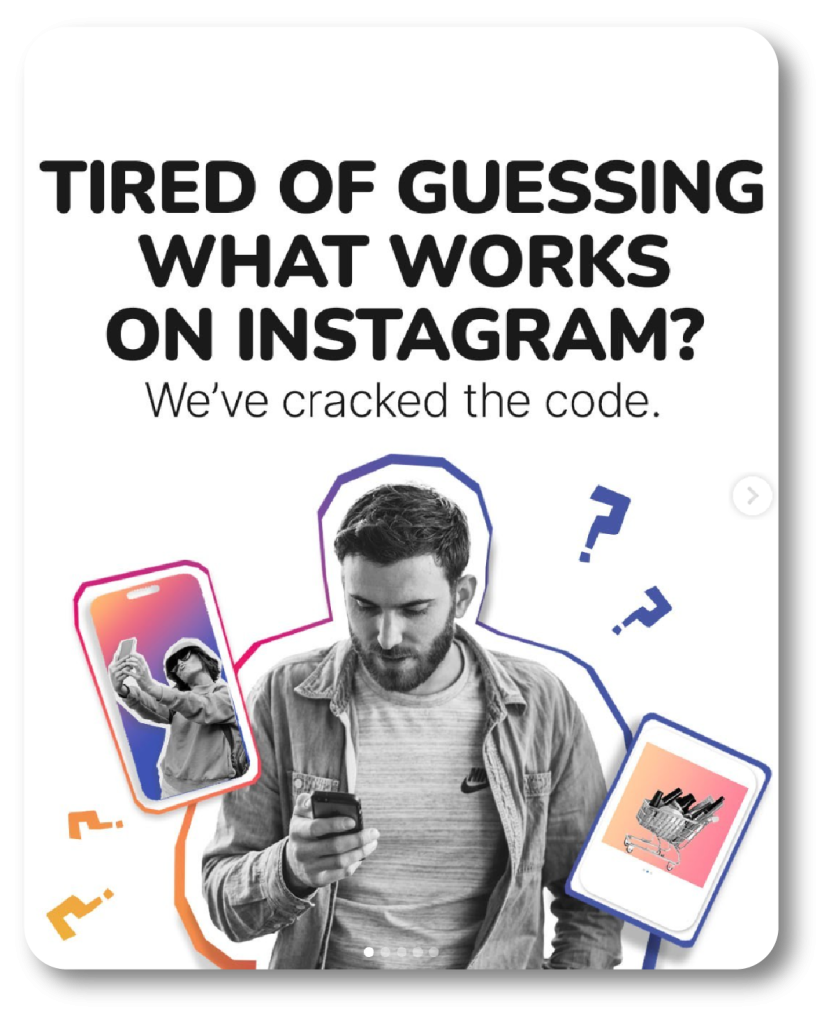
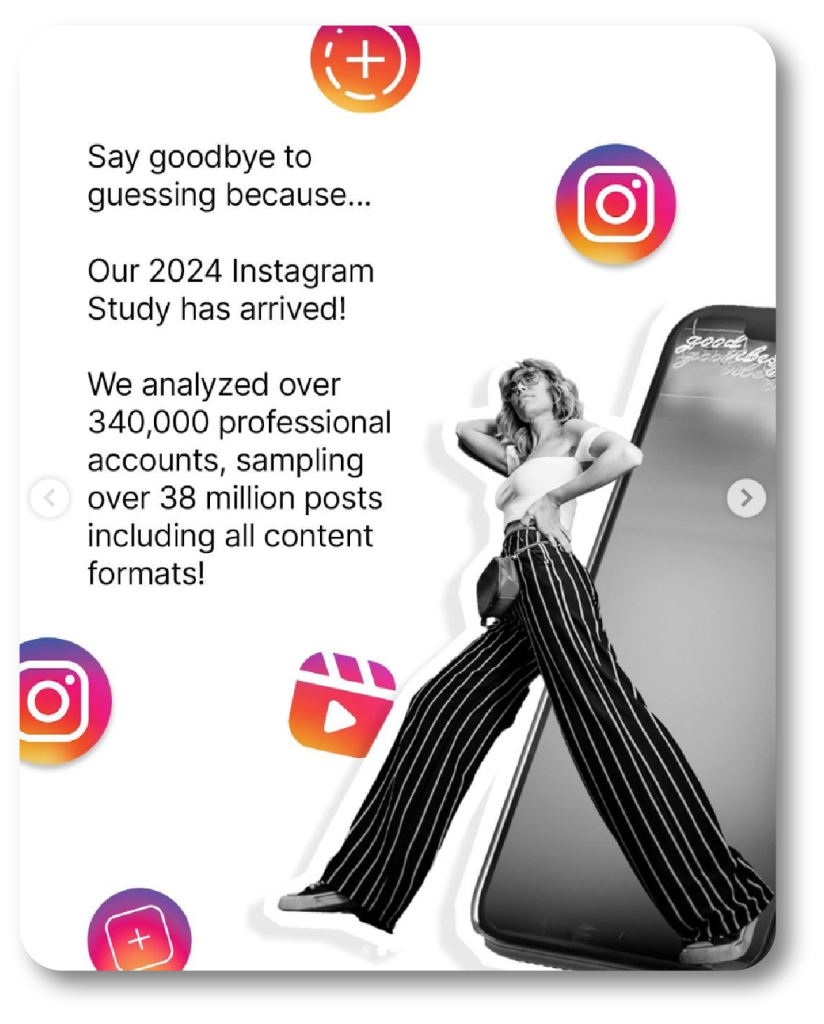
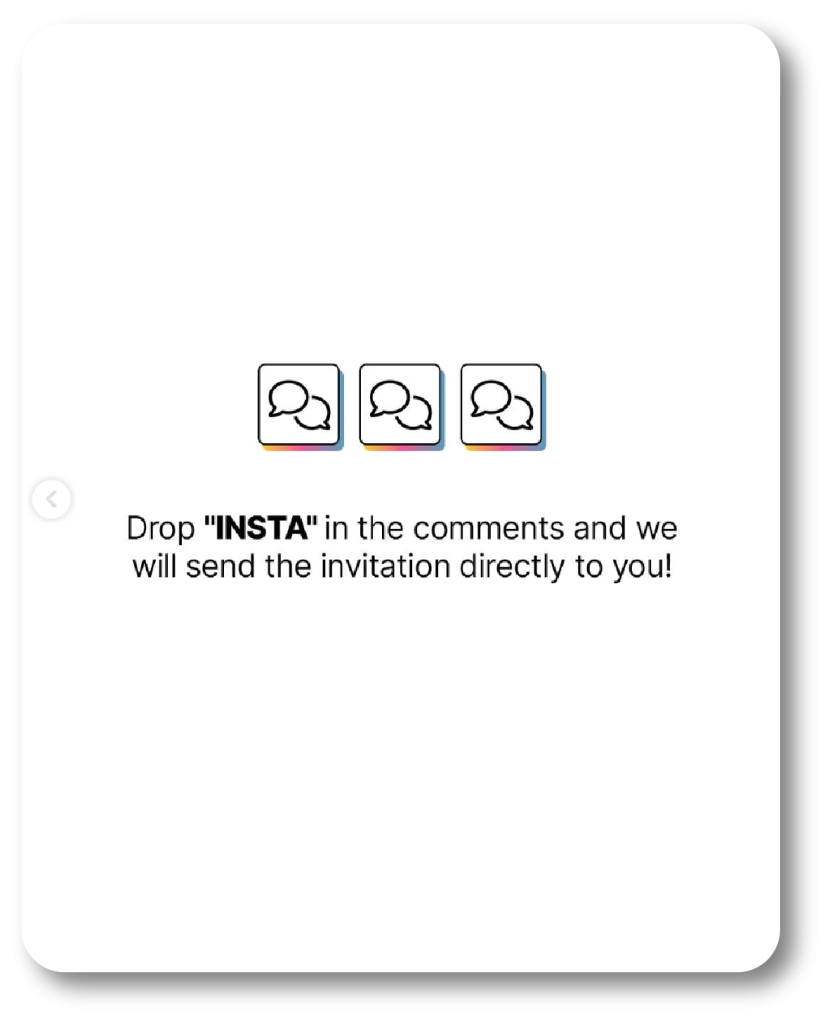
6. Engage with your stories.
“New Post” stories are not going to make you grow on Instagram. Stories are just not the place for growing a following in general, instead, this is the format to help strengthen your community. Uploading exclusive and dynamic content and getting your audience engaged is key. Planning to post a lot of stories? One quick tip is to remember to change up the angle. This will help retain the audience’s attention. You can also add interaction stickers to encourage participation.
7. Create Reels that do not encourage scrolling.
How? Use hooks that capture attention from the first second. Here is a blog with ideas for crafting great Reels. Put them to the test in your next videos.
8. Use storytelling to connect with your audience.
Users connect better with content that conveys a clear message or stirs an emotion. So when you create your next post or upload a story think about what you want users to feel or do when they see your post. If you feel stuck, think back to your brand values and what causes or situations you can connect your brand to. This can include how your brand helps your clients or even what issues your brand supports.
9. Use editing tools to stand out from the crowd.
Use tools like CapCut, Mojo, Canva, Lightroom, Tezza, or VSCO to give your images and videos a distinctive touch. You don’t need to create the fanciest videos or have professional editing on your images, but there are minimal changes you can make that can help you reach more users. For example, zooming in on key moments, adding captions to reach more users, or adding titles to highlight the most relevant information. Check out our Capcut guide if you want some video editing tips!
10. Call to action.
Content without a call to action (CTA) is lost content. Invite your users to do something: follow you, take a look at the rest of the posts on your profile, visit your online store, or share the content so that it reaches more people. Take note of the tips and examples we give you in this blog and put them into practice in your next posts.
3. Schedule your Instagram content
If your motto is to work smarter, not harder, scheduling your Instagram content will be a lifesaver. Not only does this save you from jumping to multiple applications to post content manually, but it also allows social media managers of all expertise levels to organize their content effectively.
To schedule your Instagram content, you have 2 methods:
- Meta Business Suite. Meta’s free tool allows you to schedule Instagram posts, videos and stories.
- Metricool. In addition to being able to publish all Instagram formats, the tool lets users schedule content months in advance, and auto-publish to the networks so you don’t have to.
Whether you plan to just publish to Instagram, or want to post to multiple networks at once, Metricool supports all major social media platforms.
In addition to the basic functionalities: tagging people, products, collaborators or locations, you have the best times to post at a glance, a hashtags search engine to find the perfect hashtag for your post or even the AI assistant to give you a hand with copy on days when inspiration fails. Metricool is an authorized tool and Meta Partner, so you can schedule your content with confidence and enhance your strategy.
Plus, remember that CSV template we talked about when building your ideal client persona? You can use this to bulk schedule your content and bust out your content planning in one sitting.
Or, if a CSV isn’t your thing, Metricool’s Google Drive integration on a Premium account lets you pull images, videos, and GIFs, to schedule and share all types of Instagram content. Once connecting your Drive account, find all your social assets without jumping platforms.
4. BONUS: Instagram Ads
Surprise, here’s a little bonus section in case you’re feeling extra eager with Instagram.
We’ve talked all about organic strategies, but let’s address the elephant in the room. How do Instagram ads play a role in a marketing strategy? Are they worth it? When used strategically, Instagram ads can affect reach, engagement, and visibility.
Here’s a small guide to advertising on Instagram. If you’ve already worked on your organic content, ads will help you take the next step in your overall strategy.
Ads can be found at every corner of the app, from Stories to Reels to Explore to Shopping. If you haven’t seen the results you were looking for, you may not be taking advantage of Instagram’s full advertising options.
4.1 How to create Ads on Instagram
Follow these steps to set up your ads correctly.👇🏻
1. Define your ad objective:
Before you start, choose a clear objective for your campaign. Instagram offers several options, such as increasing brand awareness, generating website traffic, getting more engagements or driving conversions. Select the one that best suits your needs.
2. Set your budget and schedule:
Define how much you are willing to invest in your ad campaign and for how long. Instagram allows you to set a daily or total budget, and you can adjust the duration of the campaign according to your goals.
3. Target your audience:
Use Instagram’s advanced targeting tools to reach your ideal audience. You can create audiences based on interests, behavior, location and demographics. You can even use custom or lookalike audiences to maximize your effectiveness.
4. Select your ad format:
Instagram offers a variety of formats, including ads in Stories, feed, Reels, and Explore. Choose the format that best suits the type of content you want to promote. Each format has its advantages, depending on your audience and the message you want to convey.
5. Create attractive visual content:
Visual quality is key on Instagram. Make sure your ad has an attention-grabbing design, whether it’s a striking image or a dynamic video. Don’t forget to include a clear and direct call to action (CTA), such as “Shop now”, “Sign up” or “Find out more”.
6. Monitor and Adjust:
Once the ad is live, it is important to monitor its performance. Instagram offers key metrics to measure the effectiveness of your ad, such as impressions, clicks and conversions. Review performance regularly and adjust budget, targeting or content if necessary. You can do this from Facebook Ads Manager or from Metricool, where you also have the “Ads” section where you can create and analyze your Instagram campaigns.
4.2 Instagram ad formats: Everything you need to know
Instagram offers a variety of ad formats, and it’s important to know which one to choose based on your goals and the type of content you want to promote. Here’s a rundown of the most common formats and how to get the most out of them:
- Feed Ads: perfect for your promoted posts to appear in users’ feeds organically. These ads are ideal for showcasing products or services, and you can include a personalized CTA such as “Buy now” or “Learn more”.
- Reel Ads: Take advantage of the short video format to reach new audiences in a dynamic and creative way.
- Ads in the Explore section: Your ad will appear on the “Explore” page, where users go to search for new content. Create a compelling piece of content with a clear message. This way users who like your product or service can discover you.
Mini-guide completed! Want to dive deeper into Instagram Ads? Check out this Instagram Ads Mega Guide to get your ads rolling.
If your brand is also active on Facebook, we highly recommend creating campaigns for both platforms to maximize your efforts. But, we know what you’re thinking, Meta Business Suite can be quite confusing and overwhelming for first-timers. Thankfully there are other options available, like Metricool’s built-in advertising features. Choose your objective – traffic, engagement, leads, or sales – and select the placements for your ads. You can even plug in your Facebook pixel and choose your preferred event conversion to track your campaigns with precision.
The intuitive platform walks you through each step of the campaign-building process, targeting your audience, selecting the locations, adding your assets, and budgeting. Then, track your campaign results and create monthly reports to measure the effectiveness of your paid advertising strategy. This is how you can improve, using the data to analyze areas of opportunity and growth.